Contact
Tööstuse 43, Tallinn, Estonia
Store: +372 508 3309
Workshop: +372 5301 8568
Tähesaju tee 31, Tallinn Estonia
Store: +372 5885 7752
Workshop: +372 5301 6938
Info: +372 508 3309
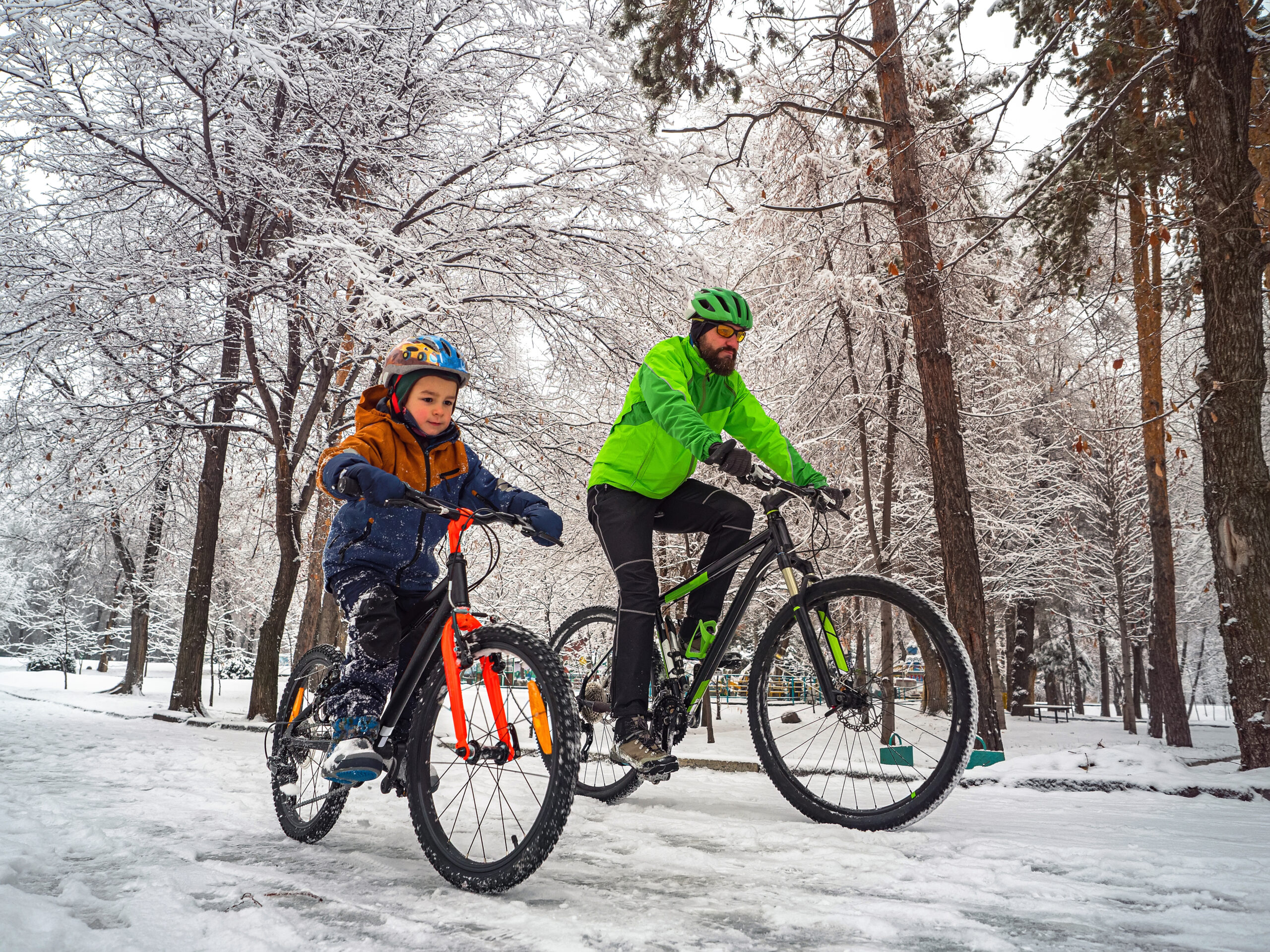
Autumn is over and the rain is slowly giving way to snow. With the snow coming, many people put their bikes in the winter garage to wait for spring, when the snow and ice have melted. It often doesn’t occur to people that it is possible to cycle in winter. Or people mistakenly believe that winter equipment is expensive and difficult to obtain, perhaps even that a different bike is needed. Those who would even like to ride in winter may not know much about winter equipment or maintenance. For example, that there are also winter tyres with studs for bicycles!
With a fast ride, the Velomarket team wants to leave doubts and hesitations far behind and encourage and convince readers that cycling can be very enjoyable even in winter. We provide guidance and knowledge on how to prepare for winter riding – what winter equipment is needed for the bike and the rider, and how to maintain the bike.
If, after reading through this blog post, we still haven’t convinced you of the refreshing benefits of winter riding and you want to give your two-wheeled friend a break for the winter, a Velomarket mechanic will guide you: “How do I prepare my bike before putting it in the winter storage?” .
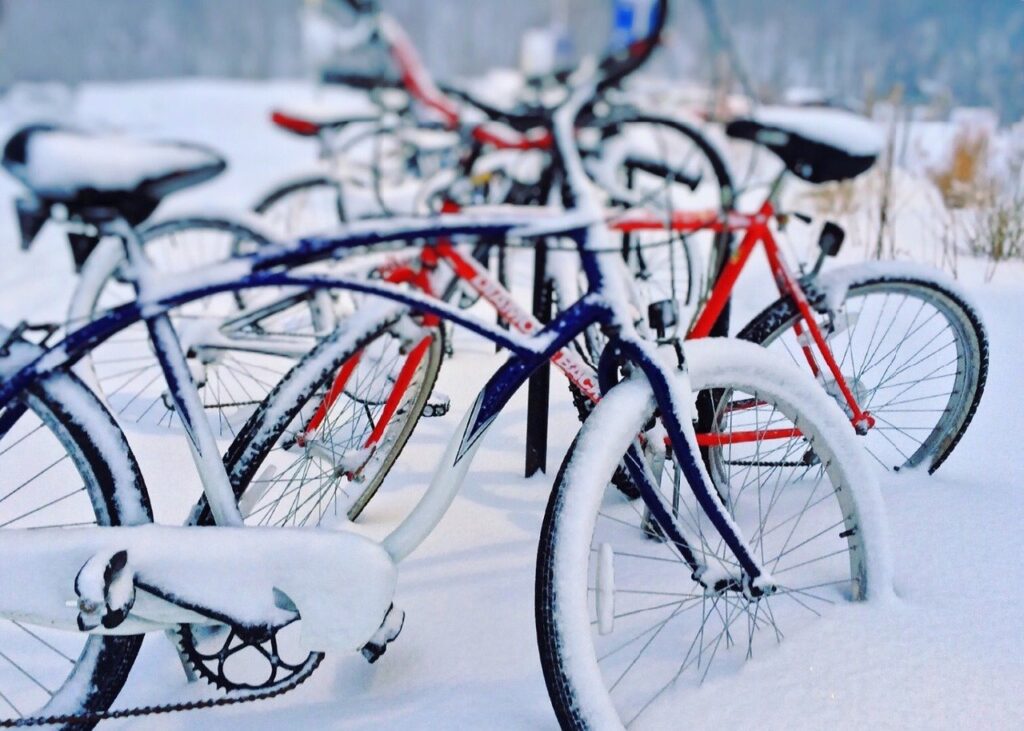
Choosing the right clothing, i.e. whether to dress warmly or lightly, is a matter of individual trial and error. Clothing depends entirely on the nature of the ride – duration, intensity, temperature. People wrongly think that because it’s very cold outside in winter, it makes perfect sense to dress warmly and properly. In fact, you’re getting rather too warm! After all, cycling is a physical activity, just like skiing, and anyone who is familiar with skiing already knows that there’s no point in dressing up. Rather, emphasise windproof clothing so that the wind doesn’t cool you down too quickly. The wind is the biggest source of heat loss, and when you’re cycling, you inevitably create the wind.
If you’re going on a longer trip, you can dress warmly at the start, so you can take fewer clothes and put them in the rucksack if necessary. Or take something just in case. If the ride is urban and short, there is no need for special sportswear. The things you already have in your wardrobe are probably enough.
For sporty driving, layered clothing is the most important thing. Wear several layers of clothes as this keeps you warm. Natural wool is best, but there are also good synthetic materials. Outerwear should be waterproof and windproof. Special cycling clothing is wind and waterproof at the front and breathable and moisture-wicking at the back. You may also be wearing two or three pairs of socks, with the thinner ones always underneath.
The toes and HANDS are the places that get cold easily. Lab gloves are warmer than mittens because they keep your fingers together and keep them warmer. However, the feel of the bike while riding is not as good as with knuckles.
KEEP YOUR FEET dry and warm with woollen or wool-blend socks and comfortable windproof boots.
Keeping the head warm is the most important thing, as ~10% of body heat is lost through the head. Helmet hats are available, which are sufficiently thin and seamless. Other hats with smaller stitches also work well. It’s important that it’s comfortable and the helmet fits. Helmets can be adjusted to fit you exactly, depending on the thickness of your hat.
A normal scarf or buffer is suitable for covering the NÄO . There are also special windproof masks that stay on more securely. A trap or bumper can easily sink down and become a distraction while driving. A wide range of sports goggles are suitable for eye protection, from ordinary sunglasses to large sports goggles with straps behind the head.
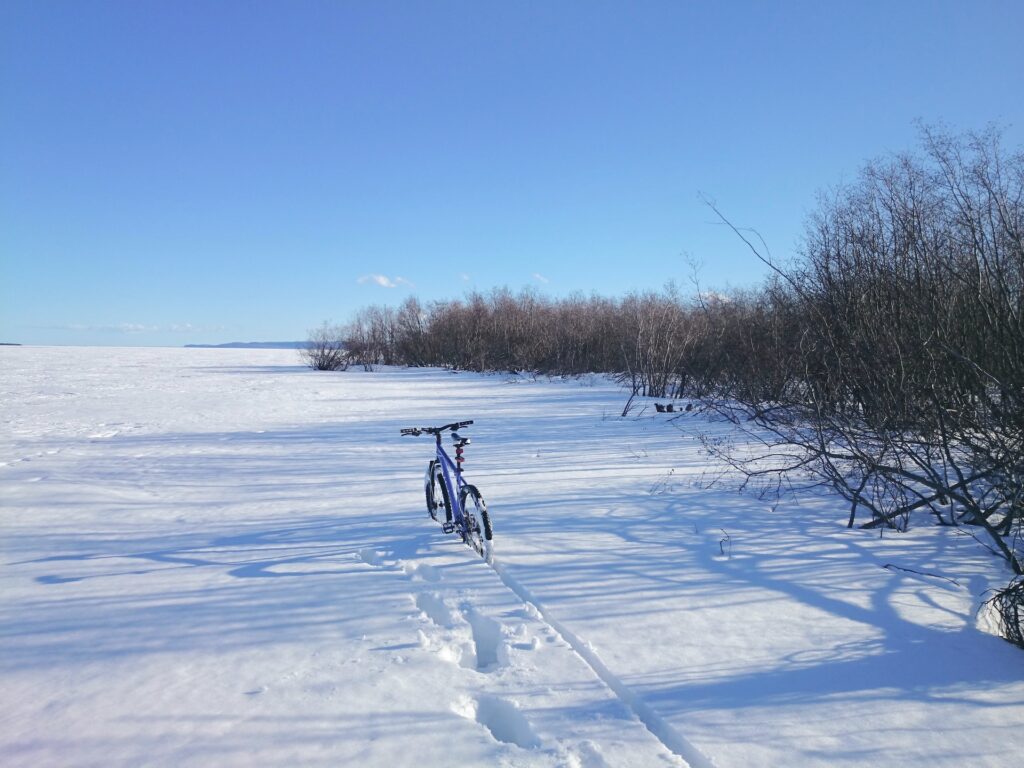
The REHVIVAL of bicycles is quite high. Winter tyres have a deeper pattern, and studded tyres are also available. Here it is important to know which road is most used, whether it is an unpaved road, which is often slippery and icy, or an urban road, which is usually clean. Deep-patterned tyres help you ride in the snow. Studs only help when the tyre comes into contact with ice – where normal rubber slides well, but studs get stuck in the ice and stop the wheel from sliding. On asphalt, on the other hand, it’s slippier with studs than without, because the studs can’t penetrate the road surface. If road conditions are constantly changing, tyres with studs on the sides of the tyre rather than across the tyre would be best. That way, the tyre has a better grip on the asphalt, and if there is any ice, the lateral studs still grip the ice and prevent slipping. One more important point – winter tyres should be lower pressure, i.e. slightly deflated. Then the rubber sinks wider and there is more contact with the ground, hence better grip.
PORILOADES are indispensable in wet, slush and snow. The most effective are undoubtedly long pore boards. Here’s one thing to watch out for – as the snow/slush accumulates on the side of the wheel, it can start to rub against the powder boards. This in turn takes the momentum out of the wheel, as the dust traps turn into a tyre wiper, which is nice, but also acts as a brake. To sum up: the mudguards should be mounted/set far enough away from the tyre to prevent snow from getting stuck in between.
BICYCLE LIGHTS are a must in winter, not only in the evening, but also during the day, as it is often quite dark during the day. Flashing lights are easier to spot from a distance, and it is the tail light that could be in flashing mode (which also doesn’t use batteries as much as a steady light). Always make sure that the batteries are fully charged, as they drain more quickly in cold weather. A spare battery or rechargeable battery may also be included. It’s a good idea to have a headlight on your helmet and a taillight on your backpack, for example, so you can take the lights with you into the warm room anyway. A reflector on your pedals and especially on your bike wheels will help drivers spot you. Reflective elements are also very useful for clothing. The main thing is to be clearly visible to other road users, especially drivers.
BICYCLE BAGS that attach to a luggage rack or handlebar are very practical, as you don’t have to carry a backpack, for example. However, for those for whom a rucksack is the most comfortable option, there are rucksacks that attach to the pack frame and don’t look at all like a bike bag. You can always put a rain cover on the bag to keep rain, sleet, snow and dirt out.
If possible, always keep the bike in a cool place. The constant alternation of minus and plus degrees, freezing and thawing of water does not work well on smaller parts. You know that water expands when it freezes. So water that has melted indoors and got into smaller cracks freezes and swells outdoors in sub-zero temperatures, wearing away moving parts. If you don’t have a shelter, put a cover on your bike, as the weather is often changeable and there are always fluctuations in the plus and minus degrees. That way, your bike won’t get wet or buried in snow for nothing. It’s also more comfortable for you if your bike is dry, clean and always ready to go.
If the chain is dry and unlubricated, both the chain and the gears will wear quickly. With proper care, they will last many times longer. It is important to use the right care products. Be sure to use chain oil for bikes, as it has the right viscosity for the bike – it won’t collect too much debris/dirt, won’t wash right off in the rain. There are chain oils specifically for rain and cold. There’s a wide choice, and in winter, use a chain oil that’s just right for rain and sub-zero temperatures. For a more in-depth look at bike maintenance, see the Velomarket blog post. “How to care for your bike in autumn and winter?” .
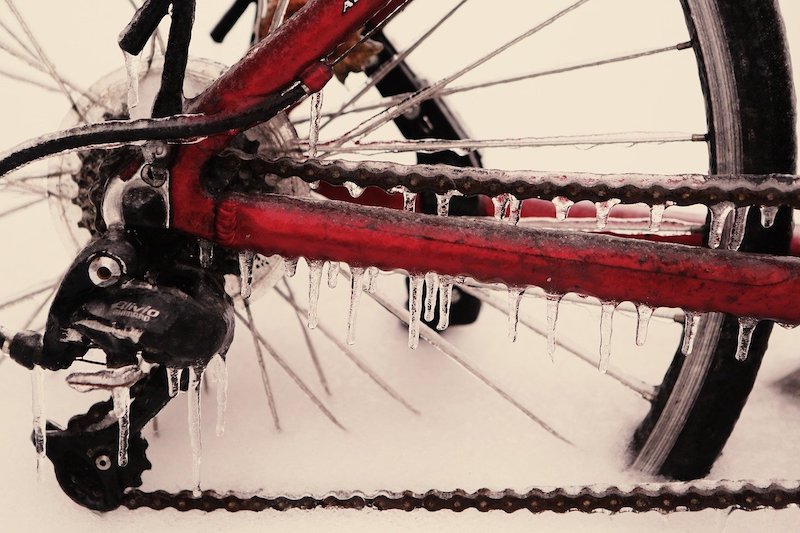
It’s easier to drive on soft terrain and in snow and slush when the tyre is softer. This means deflate the tyre a little. This way, the tyre’s grip on the ground is stronger and the wheel doesn’t roll around or slip as easily.
Speed is not dangerous in itself when driving on snow and ice, but sudden movements that can cause you to fall. Acceleration and braking must be smooth. When turning, slow down or take a bigger turn and try to stay more upright – don’t lean too much to one side.
The golden rule is don’t be too tense, don’t overreact. In winter, when driving in snow-covered wagons, it always happens that the front or rear wheel slips and makes a sudden jerk. It’s important that you’re relaxed when you’re riding, so it’s much easier to adapt to steep bumps and keep your balance. If you get a stutter, there’s no need to over-steer. The wheel will probably slide into its casing and stay there, and the wheel will move on nicely. When you’re relaxed, you’ll feel better and know where to intervene. Of course, you get that feeling with practice, but there’s no need to give up immediately if the first few rides are very bumpy. It comes with snow and ice in winter.
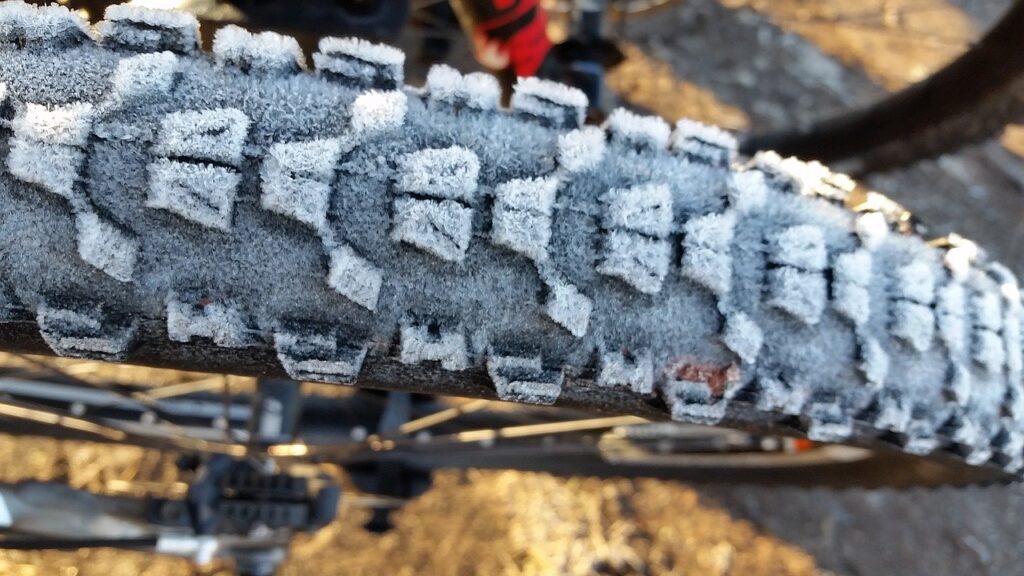
Cycle paths can disappear under the snow or become narrower, depending on where the snow can be pushed by the ploughs. Road verges can therefore become bumpy and hide hard patches of snow or ice. Tyre tracks from cars and other cyclists can also be icy, creating sharp, deep grooves. It is therefore not sensible to drive at the same speed as in summer and autumn. It may no longer be so easy to drive over and through from all sides, and always anticipate the unexpected.
Be careful on junctions, drive smoothly and be aware that cars may not always stop quickly and may slide forward. However, drivers are generally more cautious in winter and don’t speed so much. The smartest thing to do is to drive in a way that allows other road users to anticipate your movements and gears.
There’s always a chance that another route will be better for the winter. Be sure to check out the local roads and take a different route, even if it’s a corral. That way you can find a quieter route and maybe even a faster one.
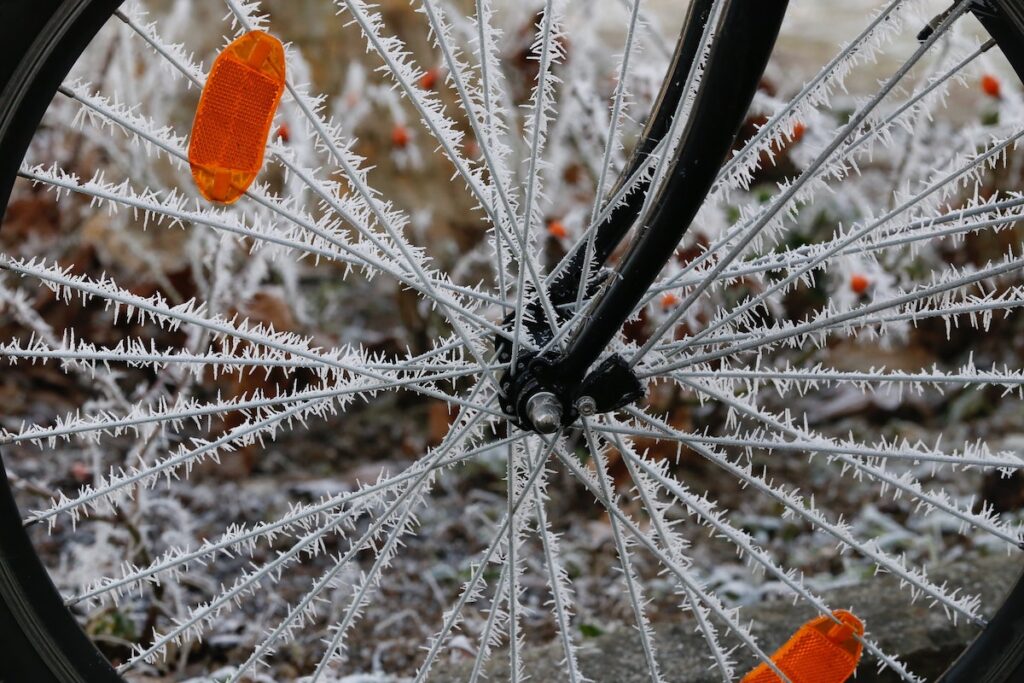
It turns out that there’s no need to lock your two-wheeled friend in a shed or a cellar for the whole of a great season. We hope we have been able to introduce you to winter cycling opportunities and useful tips that will encourage you to continue cycling in winter! If you have any questions about bicycle equipment or anything else, feel free to contact the Velomarket team.